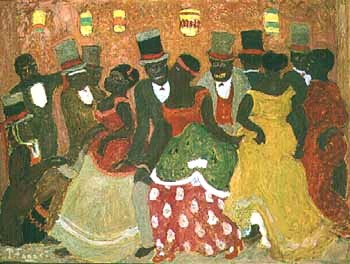![]() AFRO CUBAN IDENTITIES. ORIGINS.
AFRO CUBAN IDENTITIES. ORIGINS.
Abakuá
In Cuba, peoples from southeastern Nigeria and southwestern Cameroon were known as Carabalí or Bríkamo, and they included the Ejagham, Efik, Ibibio, and others.
The Ngbe society became known as Abakuá, after the word Abakpa, a term by which the Ejagham of Calabar were designated. It took root in the Havana area and in Matanzas, where it became a considerable force in local politics. In eastern Cuba, two Carabalí cabildos still exist in the city of Santiago de Cuba, and play an important role in that city’s carnival. The Abakuá leopard-masker, the íreme, has practically come to symbolize Afro-Cuban folklore.
Kongo
Of all the collective terms used to specify Afro-Cuban origins, “Kongo” encompasses the greatest diversity of peoples brought to Cuba during the years of slavery. The names of the myriad Cuban Kongo cabildos reflect the geography of the slave trade or else include African ethnic designations. Sometimes they bore the names of slaving ports (Loango, Benguela and Cabinda, the last also very important for Brazil), and sometimes they specified clan origins, such as the Nsobo (Bazombo) and Mayombe (Yombe),who also gave their name to a Cuban-Kongo religion. Members of one surviving Kongo cabildo, San Antonio de los Congos Reales in the old colonial city of Trinidad, are still performing such archaic pantomime dances as the Danza de la Culebra (Serpent Dance), which was well known in colonial Havana as Matar la Culebra (Killing the Snake), and was performed by Kongo comparsas on January 6, the Day of the Kings. Many forms of contemporary Cuban music, including many of the rumba and carnival styles, are full of Kongo references and influences and display continuity with older Kongo forms.
The most common form of secular Kongo music during the 19th century incorporated the use of Yuka drums. Played in groups of three, they were made by hollowing out tree trunk sections of various sizes and nailing on cowhide heads. The largest and master drum is called the caja [Kah-Hah], which in typical Kongo fashion is held between the legs of the drummer. Another musician plays a pair of sticks against the body of the caja, often on a piece of tin that has been nailed to the base of the drum. This stick is called the guagua or cajita, which may also be played on a separate instrument. The middle drum is called the mula [Mu-Lah], and the smallest is the cachimbo [Kah-Cheem-Bo]. A guataca is played as a time-keeper, and the caja player often wears a pair of wrist rattles.Yuka dancing featured the vacunao, a pelvic movement also found in Kongo-derived dance styles elsewhere in the Americas.
During the years of slavery, sugar estate owners would often sponsor Sunday festivals, called conguerías, and invite slaves from neighboring centrales to participate. Besides yuka drumming, which can still be found in some parts of rural Cuba, they featured song contests between competing soloists, called gallos, as well as makuta dances and maní, a now obsolete combat dance roughly similar to Brazilian capoeira.
After the Haitian revolution, many refugees, including French planters and their slave, fled across the narrow Windward Passage to eastern Cuba, where they established coffee plantations in the highlands around Santiago de Cuba. In that city and in Guantánamo, some of their former slaves and their descendants, who had clung to their Afro-Haitian culture, established their own cabildo-like associations, known as tumba francesa, or “French drum.” There they played Haitian-style drums and performed dances with names such as masón and yubá (juba), similar to those found in Haiti today, and sang in Creole.
Arará
The people known in Cuba as the Arará came from Dahomey, what is today the Benin Republic. They included Fon, Popo and Ewe groups, as well as some conquered peoples to their north. Arará cabildos were founded in Cuba as far back as the 17th century, and their names reflect regional and ethnic differences – hence the denominations Arará Dajomé, Arará Sabalú and Arará Magino. The second is a reference to Savalu, a town in northern Dahomey that was conquered by the Fon. It was inhabited by the Mahi people, recalled in the cabildo name “Magino.” Many members of the Mahi priesthood were sent into slavery in the Americas, and they had an especially strong impact on Haiti vodun.
The name Arará is derived from the Dahomean city of Allada, and is related to the term Rada found in Haiti and to Arrada on the tiny island of Carriacou in the Grenadines. In both cases the name refers to Dahomean styles of drumming. Other outposts of Dahomean culture in the Americas include houses in the Brazilian cities of Sáo Luis do Maranháo, Salvador, Recife and Porto Alegre. In Cuba the Arará were always a minority overshadowed by the Lucumí, and their distinctive cultural identity is now in danger of disappearing. Arará centers are still to be found in Ciudad de Matanzas, Jovellanos, Máximo Gomez and el Perico, all in Matanzas.
One characteristic of Arará music is the use of hand clapping and body percussion.
Agencies/Wiki/AfroCubanEnlaces/MusicalAnthology/InternetPhotos/Youtube.
THE CUBAN HISTORY, HOLLYWOOD.
Arnoldo Varona, Editor.






